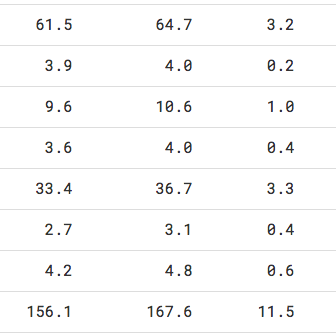2016 Employment Projections by Educational Requirements

By Former Chmura Staff |
The Bureau of Labor Statistics recently released its employment projections for 2016,[1] forecasting the change of employment by occupation ten years into the future. Included in this analysis is the attribution of each occupation to a specific category of “typical education for entry.” Grouping the employment numbers and estimates by these categories, we are able to see how employment is likely to change across various levels of educational attainment.
| Typical education needed for entry | Employment, 2016 (millions) | Projected Employment, 2026 (millions) | Projected Total Change (millions) | Projected Percentage Change | |
|---|---|---|---|---|---|
| No formal educational credential | 37.2 | 39.6 | 2.4 | 6.4% | |
| High school diploma or equivalent | 61.5 | 64.7 | 3.2 | 5.2% | |
| Some college, no degree | 3.9 | 4.0 | 0.2 | 4.2% | |
| Postsecondary nondegree award | 9.6 | 10.6 | 1.0 | 10.8% | |
| Associate's degree | 3.6 | 4.0 | 0.4 | 10.9% | |
| Bachelor's degree | 33.4 | 36.7 | 3.3 | 10.0% | |
| Master's degree | 2.7 | 3.1 | 0.4 | 15.8% | |
| Doctoral or professional degree | 4.2 | 4.8 | 0.6 | 13.5% | |
| Total, all occupations | 156.1 | 167.6 | 11.5 | 7.4% | |
| Source: BLS | |||||
Jobs requiring postgraduate degrees are projected to grow at the quickest rate over the next ten years—with those requiring master’s degrees projected to grow by 15.8% and those requiring doctoral or professional degrees expected to grow by 13.5%. Occupations in this group include lawyers, physicians, physician assistants, and nurse practitioners.
By sheer number, the largest projected increase in employment belongs to occupations requiring a bachelor’s degree. Despite only representing about half the amount of total employment, these occupations are expected to add even more jobs than occupations requiring only a high school diploma. Among the 3.3 million jobs expected to be added for jobs requiring a bachelor’s degree, the occupations with the highest projected growth rates are software developers, applications; information security analysts; and operations research analysts.
While occupations requiring bachelor’s degrees are expected to add slightly more jobs between 2016 and 2026, the largest amount of total employment still belongs to occupations requiring a high school diploma or equivalent. Among these, the occupations with the highest levels of employment are general office clerks and customer service representatives. Home health aides and personal care aides are two occupations requiring high school diplomas that are expected to grow significantly between 2016 and 2026, projected to expand employment 46.7% and 37.4%, respectively.
The story is clear: jobs requiring higher education are generally expected to have better job growth. As we’ve written previously, there are other benefits to higher education as well, benefits for individuals as well as communities.
[1] BLS Employment Projections: Occupational projections and worker characteristics. https://www.bls.gov/emp/ep_table_107.htm
Subscribe to the Weekly Economic Update
Subscribe to the Weekly Economic Update and get news delivered straight to your inbox.